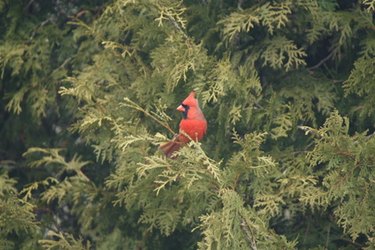
The red cedar tree is actually not a cedar tree at all, but a juniper tree. Cedar trees are limited to the Mediterranean region, while eastern and western red cedar trees grow in the United States in different habitat ranges. The red cedar tree is a pine tree, or conifer. Eastern and western red cedar trees play vital roles within their ecosystems, providing shelter and food for many types of wildlife.
Eastern Red Cedar Habitat
Video of the Day
Eastern red cedar grows in the eastern United States. Hardy by nature, it grows in various types of soil, from river banks to dry rocky slopes or bluffs. Its habitat range extends east of the Great Plains, starting from southern Canada and reaching all the way to Florida and west to Texas.
Video of the Day
Western Red Cedar Habitat
The western red cedar thrives throughout the coastal fog belt. They grow from Alaska to northern California, and east to Montana. The predominant habitat of the western red cedar is moist, lush forest areas such as stream banks, damp ravines, forested swamps and wet lowlands. Sometimes it is found growing on rocky slopes. This tree grows in mixed conifer forests, often along with western hemlock and Douglas fir.
Common Uses of Eastern Red Cedar
Eastern red cedar heartwood has unique properties. Its bold fragrance oils are not only pleasant smelling but repel insects. Red cedar is often used for closet paneling and cedar chests. This wood is very durable and frequently used for fence posts. Eastern red cedar is also called pencil cedar, because in the past it was used to make pencils until less expensive woods and synthetic materials replaced it. Cedar chips and sawdust are often used to repel ticks and fleas. According to the University of Florida School of Forest Resources & Conservation, herbalists use red cedar to treat a variety of ailments, including bronchitis, colds, rheumatism, arthritis and asthma. The leaves can be used to alleviate skin rashes. Made as a tea, red cedar can ease nerves and some have claimed it relieves headaches.
Common Uses of Western Red Cedar
Western red cedar's soft wood has many uses. It is a popular wood for siding and shingles, as well as for fences, decks, windows, doors, poles, frames and moldings, outdoor furniture, boats, saunas and gazebos. It is unique in that it is one of the lightest conifer woods and its soft texture makes it easy to work with without needing specialized equipment. At the same time it is known as being extremely durable. In fact, a fallen cedar tree will not decompose quickly, but rather can last for over a century. The wood contains a natural preservative that is toxic to fungus that causes decay. Amazingly, as the tree ages, the preservative gains strength rather than weakening.
Wildlife and Red Cedar Trees
Both eastern and western red cedar trees play significant roles in their ecosystems. The eastern red cedar tree's berries are winter food for a lot of songbirds. The birds help the eastern red cedar by spreading the tree's seeds through its excrement. Other birds, such as doves, build their nests with the heavy foliage to find seclusion and hide from predators. Various species of wildlife, including deer, use the eastern red cedar during winter months for food and shelter. Wildlife uses Western red cedar in similar ways. Elk feed on the foliage during the winter, while rodents and deer feed on it year-round. Black bears can be found using hollowed-out trunks as dens. Birds like Vaux swifts and spotted owls live in the branches.